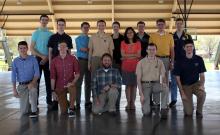University Students Use Balloon with Amateur Radio to Study Eclipse
University Students Use Balloon with Amateur Radio to Study Eclipse

By Fleet Belknap, KJ4ZWA
Bob Jones University, Greenville, SC
Observable solar eclipses are rare events, and a lot is still unknown about how they interact with earth’s atmosphere. The August 21, 2017 total solar eclipse will provide a treasure trove of information, as it will take place across the United States. In order to study the atmosphere during the solar eclipse, NASA is partnering with over 57 teams across the continent to launch balloons that will provide live video of the eclipse. While this looks like an interesting opportunity, it is way too expensive for the average Amateur Radio enthusiast; each team has a budget anywhere from $6,000 to $25,000.
A group of over 25 students from Greenville, SC are doing something different. They have developed the Stratos Project. With a current budget of under $2,000, they plan on sending a live video and scientific data to earth from a balloon at approximately 100,000 feet and inside the path of totality. Instead of using commercial satellite tracking and communications, they are using Amateur Radio. The video and some scientific data will be transmitted with an Amateur Television Transmitter (ATV) throughout the flight. They are planning on using a raspberry pi with a sense hat, GPS, & spectrometer to collect live data throughout the mission. The payload will also contain a specialized flight data computer to collect humidity, barometric pressure, and temperature as well as other scientific data throughout the flight. They will be using a low power APRS transmitter to keep track of the payload throughout the flight as well as a foxhunting transmitter as a backup location beacon.
Fleet Belknap had launched a high-altitude balloon with his freshman engineering class in the fall 2016 semester. Several other students were greatly intrigued by the idea, and were wishing that they could do it. In the middle of the conversation, Fleet and his classmate James came up with the idea of doing fundraising and launching a balloon outside of class. As the group thought about ways that they could make the mission challenging, the subject of the August 21 eclipse came up; and Project Stratos was born.
The team’s project manager is James Labadorf (KJ4IQS). He is an Eagle Scout, and has been a licensed HAM operator since 2008. The team’s lead engineer is Fleet Belknap (KJ4ZWA). He is a certified Aircraft Electronics Technician (NCATT AET) and has been a HAM since 2011. They have a combined total of over 14 years of experience in Amateur Radio.
The team consists of over 25 students with majors ranging from engineering and computer science to pre-med, cinema, and biochemistry. As with any project, there are many challenges that will need to be overcome by the team. Among these are the problems of regulating the internal temperature of the payload, payload & camera stability, and consistent communication with the payload. The Stratos team will be working this summer to overcome these obstacles and use Amateur Radio in the launch to the stratosphere.
The team is going to be making the event public by live streaming the video on YouTube. The operating frequencies for the transmitters will be released about a week prior to the launch. Any reports and/or recordings of the data would be greatly appreciated by the team.
Regular updates can be found on the team’s Facebook page: https://www.facebook.com/GRVHAB/
Donations to the project may be made at the team’s GoFundMe page: https://www.gofundme.com/GRVHAB
They are starting a YouTube Channel at: https://www.youtube.com/channel/UCpSzq41Qt1zjNbXb3Mgfdmg
